Ida: At least 1 dead, more than a million customers without power in Louisiana

At least 1 dead, more than a million customers without power in Louisiana after Ida
Ida, the powerful hurricane that was downgraded to a tropical storm early Monday, left more than a million customers without power, the entire city of New Orleans in the dark, and at least one person dead.
Ida, the powerful hurricane that was downgraded to a tropical storm early Monday, continued to lash Louisiana after leaving more than a million customers without power, the entire city of New Orleans in the dark and at least one person dead.
As of 7 a.m. local time, Ida was located about 65 miles south-southwest of Jackson, Mississippi, with maximum sustained winds near 45 mph – down from 105 mph late Sunday, according to the National Hurricane Center (NHC). The storm was moving north near 8 mph.
RELATED: Ida weakens into tropical storm, brings damaging winds and flash flooding to southern U.S.
A hurricane warning has been replaced with a tropical storm warning from Grand Isle, Louisiana, to the Alabama-Florida state line, as well as Lake Pontchartrain, Lake Maurepas, and metropolitan New Orleans.

Torrential downpours, whipping winds and rain in Grand Isle, Louisiana
This video shows torrential downpours and whipping winds as heavy flooding occurs in Grand Isle, Louisiana. This video was shared with FOX 35 by Christie Angelette.
Tropical storm conditions and dangerous storm surge, damaging winds and flash flooding are still continuing over portions of Louisiana, southern Mississippi and southern Alabama, according to the hurricane center.
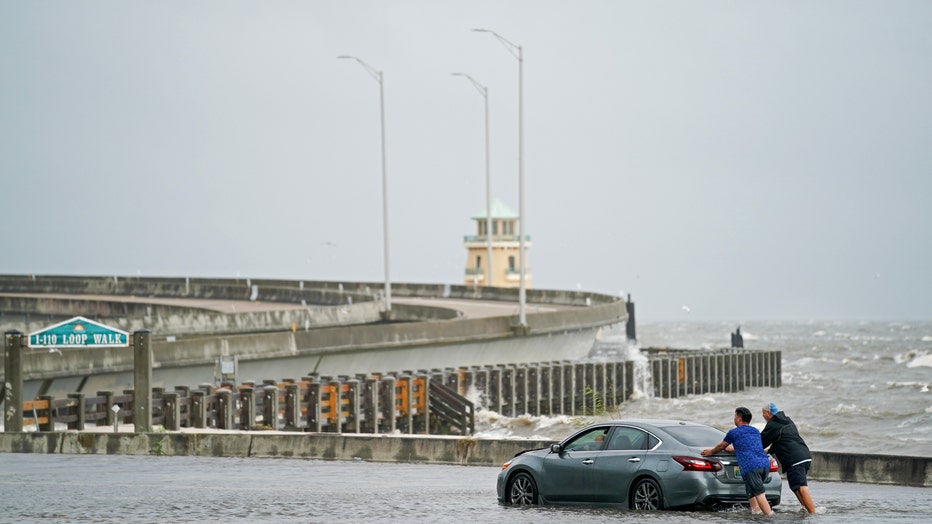
BILOXI, MS - AUGUST 30: Two men help a stranded motorist in floodwaters on Beach Blvd. on August 30, 2021 in Biloxi, Mississippi. Tropical Storm Ida made landfall as a Category 4 hurricane yesterday in Louisiana and brought flooding and wind damage a
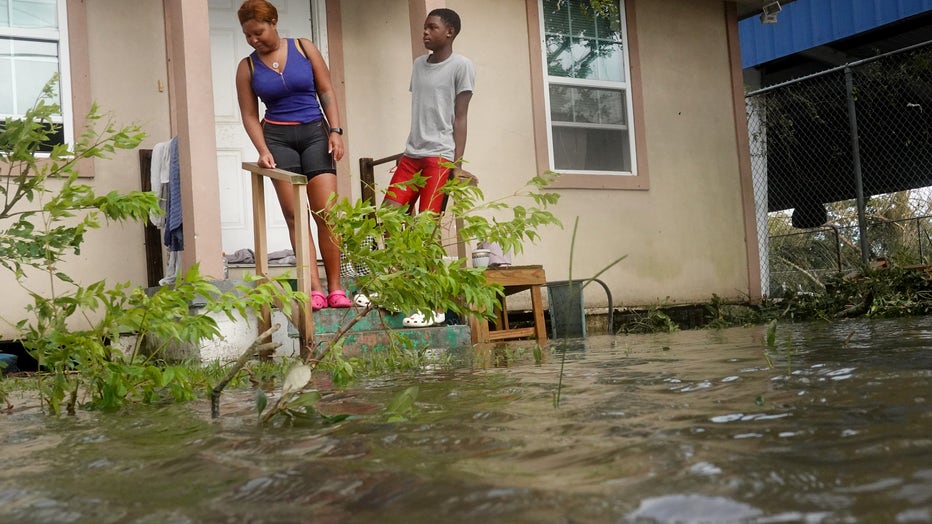
KENNER, LOUISIANA - AUGUST 30: Michelle Washington and her son Kendrick check out damage to their home in the aftermath of Hurricane Ida on August 30, 2021 in Kenner, Louisiana. Ida made landfall yesterday as a category 4 storm southwest of New Orlea
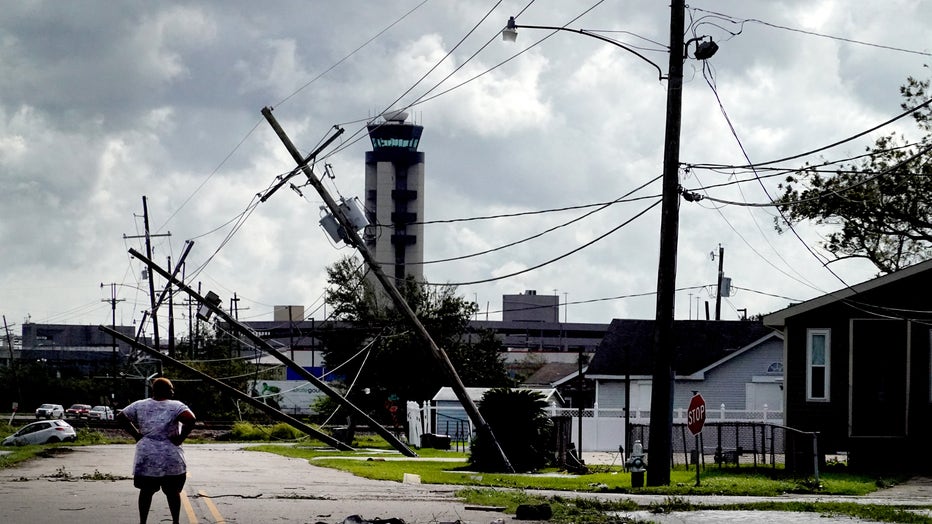
KENNER, LOUISIANA - AUGUST 30: A woman looks over damage to a neighborhood caused by Hurricane Ida on August 30, 2021 in Kenner, Louisiana. Ida made landfall yesterday as a category 4 storm southwest of New Orleans. (Photo by Scott Olson/Getty Images
The agency noted that a few tornadoes are also possible, mainly across southeast Mississippi, southwest Alabama and the western Florida Panhandle through Monday night.
Louisiana Gov. John Bel Edwards had said that Ida could be the most powerful hurricane to hit the state in more than 160 years.
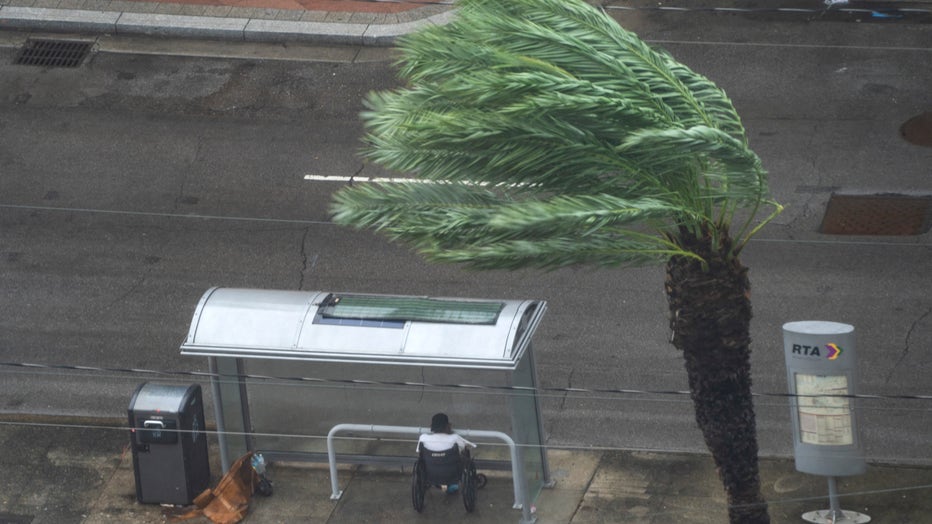
NEW ORLEANS LA - AUGUST 29 A man takes shelter in a bus stop along Canal Street as category 4 Hurricane Ida arrives on August 29, 2021 in New Orleans, Louisiana. Ida is blasting New Orleans 16 years to the day after Katrina laid waste to the city. (P
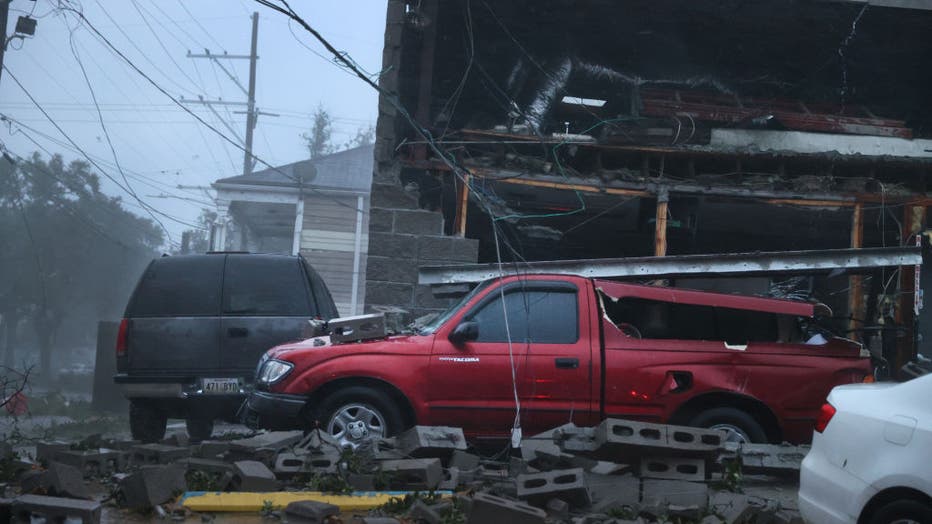
NEW ORLEANS, LOUISIANA - AUGUST 29: Vehicles are damaged after the front of a building collapsed during Hurricane Ida on August 29, 2021, in New Orleans, Louisiana. (Photo by Scott Olson/Getty Images)
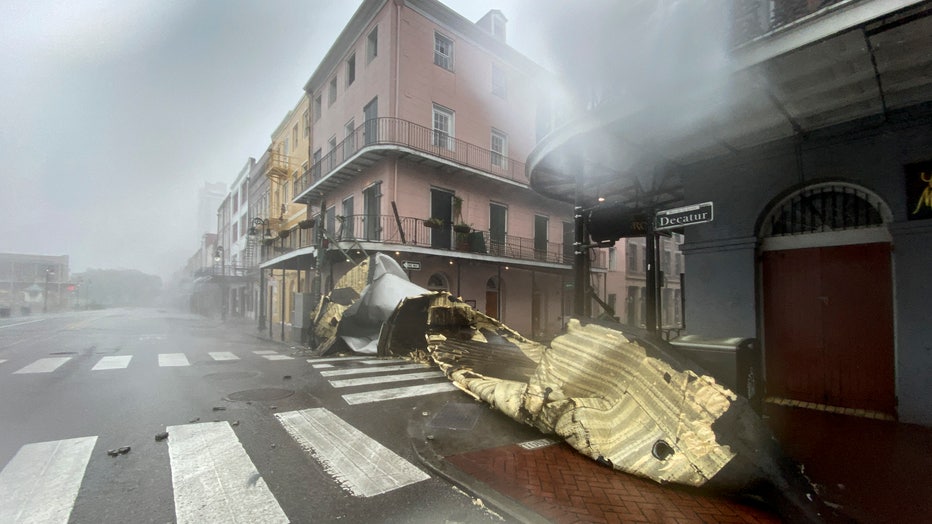
TOPSHOT - A section of a building's roof is seen after being blown off during rain and winds in the French Quarter of New Orleans, Louisiana on August 29, 2021 during Hurricane Ida. - Hurricane Ida slammed into the coast of Louisiana on August 29 as
On Sunday evening, all of New Orleans was without power, according to city officials. Entergy New Orleans, the city's power supplier, said Ida’s intensity has caused catastrophic damage, including a "load imbalance to the company’s transmission and generation."
The city relies on Entergy for backup power for the pumps that remove stormwater from city streets. Entergy said the only power in the city was coming from generators.
"We’re making every effort to learn more and rectify," Entergy tweeted.
Entergy executives said Monday that it would likely take days to determine the extent of the damage to the power grid in metro New Orleans, according to NOLA.com.

Video shows heavy wind, rain lash New Orleans
This Storyful footage was taken on Sunday in New Orleans and shows wind and rain from the hurricane lashing the city. (Credit: Kendall J Washington via Storyful)
The Sewerage & Water Board of New Orleans lost Entergy power but said in an update that its teams were working to make up for it by using their own self-generated power sources.
Residents were urged to limit water usage at home to prevent sewage backups. They were asked to minimize wastewater leaving their homes by "not running your dishwasher or washing clothes."
"We have worked to obtain backup power for some of these stations & we will mobilize those units when it is safe to traverse the city," SWB New Orleans tweeted. "In order to prevent sewage backups, we have asked residents to limit water usage at home, thus decreasing the amount of wastewater we must remove."
As of early Monday, more than one million customers were without power in Louisiana, according to PowerOutage.US, which tracks nationwide outages. More than 113,000 customers also didn't have power in Mississippi.
The first death related to Ida was reported in Prairieville, Louisiana, according to the Ascension Parish Sheriff's Office. The unidentified person was found dead following reports of a fallen tree on a home.
"Tonight, we have confirmed at least one death and sadly, we know there will be others. Thousands of our people are without power and there is untold damage to property across the impacted parishes," Edwards wrote in a statement late Sunday.
Edwards, a Democrat, had requested President Biden declare a major disaster for Louisiana. Biden did so on Sunday, ordering federal aid to supplement state, tribal and local recovery efforts in the areas impacted by Hurricane Ida.

Louisiana man recorded destruction of home after roof ripped off
A man in Houma, Louisiana, began filming after Hurricane Ida ripped the roof off his home, allowing wind and rain to lash the interior, following the storm?s landfall in the south of the state. In an Instagram post, Trevon Gauno said he was in his room when the roof was pulled away by the force of the hurricane. Surveying additional damage to the structure, Gauno said ?life is bigger than material things.? He told Storyful that he was able to seek shelter at a relative?s home nearby. (Credit: @trevongauno via Storyful)
Significant flooding was reported late Sunday night in LaPlace, a community adjacent to Lake Pontchartrain, meteorologists in New Orleans said. Many people took to social media, pleading for boat rescues as the water rose.
Meanwhile, the mayor of Jean Lafitte, Louisiana, said rescue teams were being put together to save up to 200 people believed to be in immediate or imminent danger after tidal surge overtopped levees.
"The Town of Jean Lafitte Tidal Surge Levees have overtopped," Mayor Tim Kerner Jr. wrote on Facebook. "Please prepare yourself if you live inside the tidal surge system."
Kerner called it the "worst storm in our history," according to WGNO-TV.
"We have a small group trying to take out the people in the most imminent danger," Kerner told the station. "This is a very dangerous situation. I’ve never seen so much water in my life. We’ve lost our school and everything, but now with people’s lives, it has turned into a total rescue mission."

NEW ORLEANS, LOUISIANA - AUGUST 29: Vehicles are damaged after the front of a building collapsed during Hurricane Ida on August 29, 2021, in New Orleans, Louisiana. (Photo by Scott Olson/Getty Images)
"People’s lives are I believe at stake now," he continued. "We are trying to get them out as soon as fast as we can and as soon as this weather [breaks] we are going to send an army to them."
An evacuation order was made by the Plaquemines Parish government following reports of an apparent levee issue. People near the Alliance to Oakville Floodgate were asked to evacuate immediately after the failure.

Hurricane hunters flew through Ida's eye as it made landfall
Hurricane hunters released video of the eye of Hurricane Ida as the storm made landfall in Louisiana on Sunday just before 1 p.m. EST. The footage was filmed by the Air Force Reserve?s Hurricane Hunters. The crew made two passes through the eye as the hurricane made landfall. (Storyful video)
"There has been a failure near Hwy 23 in Alliance," the Plaquemines Parish government wrote on Facebook. "Flood waters are heading northbound on Hwy 23 from Alliance."
Other images and videos on social media captured the devastation across Louisiana.
WARNING: GRAPHIC LANGUAGE
Comparisons to the Aug. 29, 2005, landfall of Katrina weighed heavily on residents bracing for Ida. Katrina was blamed for 1,800 deaths as it caused levee breaches and catastrophic flooding in New Orleans. Ida’s hurricane-force winds had stretched 50 miles from the storm’s eye, or about half the size of Katrina, and a New Orleans' infrastructure official emphasized that the city is in a "very different place than it was 16 years ago."
The levee system has been massively overhauled since Katrina, Ramsey Green, deputy chief administrative officer for infrastructure, said before the worst of the storm hit. Green said if forecasts of up to 20 inches of rain prove true, the city's underfunded and neglected network of pumps, underground pipes and surface canals likely won't be able to keep up.

Hurricane Ida ripped off carport of home
This video from Storyful shows a carport being ripped off a home in Houma, Louisiana on Sunday. It was taken by Paulette Ristine. (Storyful video)
"On the forecast track, the center of Ida will move farther inland over southeastern Louisiana early this morning and move into southwestern Mississippi later this morning. Ida is then forecast to move over central and northeastern Mississippi this afternoon and tonight, and move across the Tennessee Valley on Tuesday," the NHC added.
Get updates on this story from FOXNews.com.

